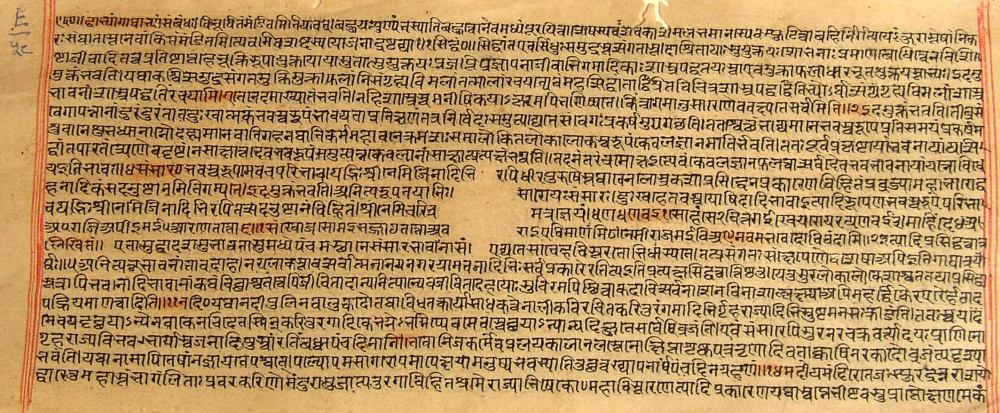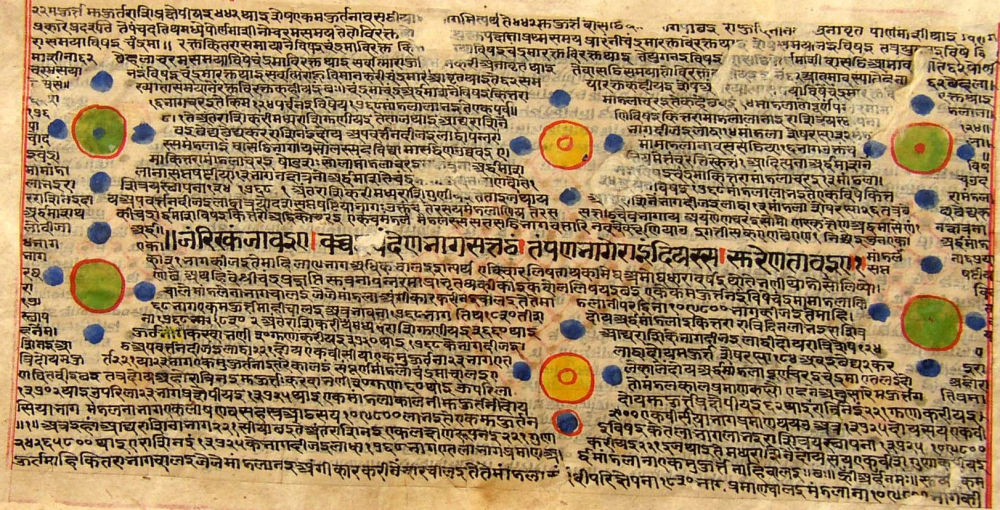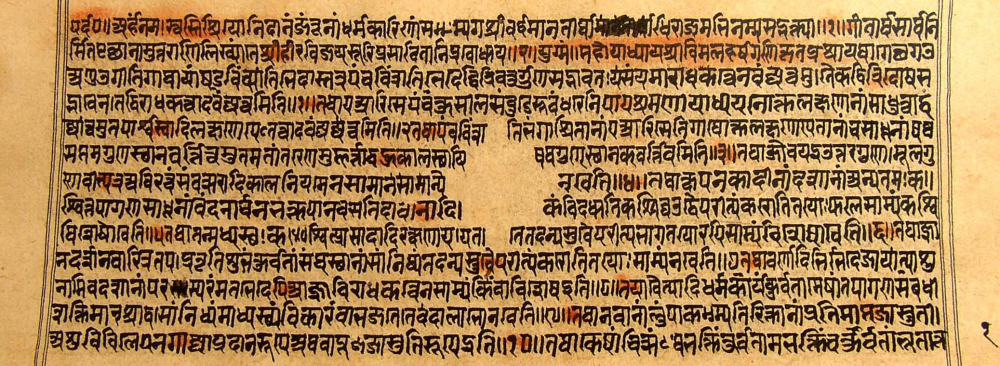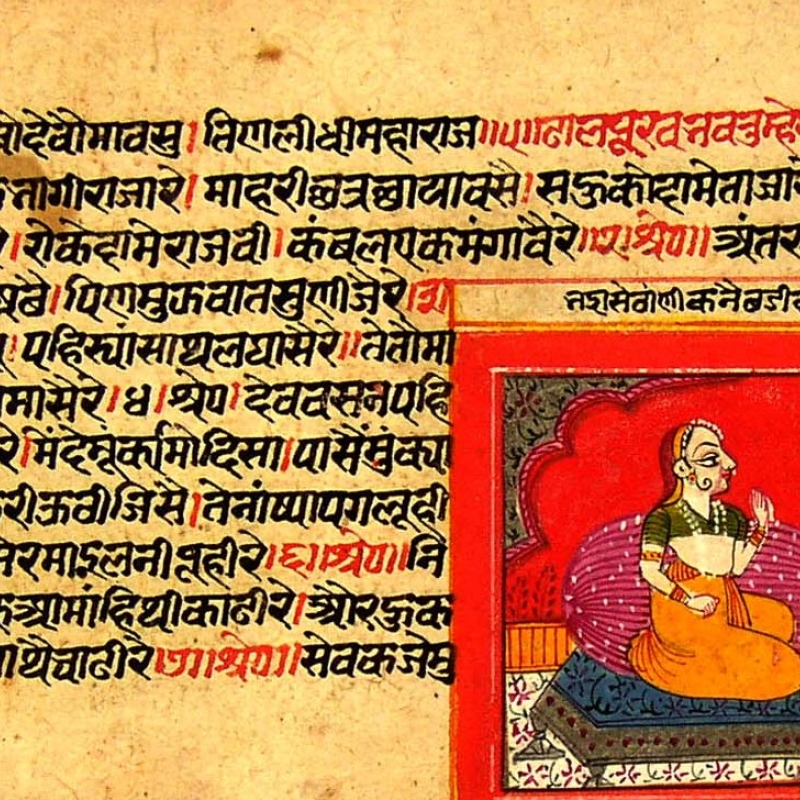The Indian subcontinent is home to a number of language families such as the Indo-Aryan, Dravidian, Iranian, Austro-Asiatic and Tibeto-Burman. A sub-group of the Indo-European language family, the Indo-Aryan language group can be divided into three categories: Old Indo-Aryan, Middle Indo-Aryan, and New Indo-Aryan. Although it is not easy to assign a date to the Old Indo-Aryan language group, the period between 1500 BCE and 500 BCE is generally accepted;[1] this group comprises Vedic and Classical Sanskrit. On the other hand, the Middle Indo-Aryan language group is said to have developed between 600 BCE and 1000 CE and is characterised by languages such as Prakrit, Pali and Apabhramsha. On a similar note, the New Indo-Aryan languages began to take shape during 1100 CE and are represented by vernacular languages like Hindi, Bengali, Marathi, Nepali, etc.
Middle Indic Languages and Prakrit
The Middle Indo-Aryan language group can be further sub-divided into three categories: Early Middle-Indic, Middle Middle-Indic, and New Middle-Indic. The first category includes languages of early Buddhist and Jaina canonical works as well as inscriptions of the Mauryan emperor Ashoka and those of the Satvahana kings of the Deccan; the second group consists of literary and dramatic Prakrits, language of the epics (Ramayana and Mahabharata), languages described by Prakrit grammarians, and extraterritorial Prakrits such as Gandhari and Sinhalese. The last phase of the Middle-Indic language group, the New Middle-Indic, is constituted by the different varieties of the language Apabhramsha that led the way for present vernacular languages to come into existence. Prakrit, the subject of this article, is an Indo-Aryan language, more specifically, a Middle Indo-Aryan language. What is generally understood as Prakrit today is associated with the middle phase of the Middle Indic-language group although a few scholars consider the Early and New Middle-Indic languages to be the older and later versions of Prakrit languages, respectively. Besides this, certain features of Prakrit can also be observed in the Vedic texts such as Rigveda, especially when its language is compared to that of its Indo-Iranian counterpart, Avesta .
Etymology of Prakrit
The term ‘Prakrit’ can be derived from the word prakriti meaning ‘nature’ or ‘origin’; thus, the meaning of prakrit can be understood in two ways: a group of languages that were natural, based on the ordinary speech of the common mass, when compared to Sanskrit, the highly sophisticated language of the learned; or, it may be seen as a group of languages derived from Sanskrit, the source language.[2] While evidence for the former can be deduced from Sanskrit dramas where the prominent characters (rulers, priests and officials) spoke Sanskrit and the less important characters (women, merchants, monks and servants) conversed in Prakrit, the latter can be gauged from the works of Prakrit grammarians who, besides composing their grammatical treatises in Sanskrit, explained the phonological features of Prakrit only in relation to that of Sanskrit. Grammarians also explain the sources of the vocabulary of Prakrit along three different lines: tatsama (words equivalent to Sanskrit), tatbhava (words derived from Sanskrit), and deshi/ deshya (provincial words whose etymology was difficult to arrive at). In addition to this, what is also interesting is that in his text Tufhat ul-Hind (Gift from India), written in 1676, grammarian Mirza Khan describes Prakrit as a mixture of Sanskrit, language of the gods, and Apabhramsha, language of men. According to him, Prakrit was employed to render eulogies for kings, ministers and chiefs, and it was also the language of the lowest of the low and of ‘reptiles’ that belonged to the nether regions.[3]
Prakrit Languages: Types and Scope
The term Prakrit is often homogeneously used to refer to its various dialects and sub-dialects; these dialects were employed for spoken and written communications, depending on factors such as geography, religious affiliation, motive of the speakers/writers and the genre employed by them. (Fig. 1) This gave rise to a world of Prakrit languages. Depending on their overall scope, these languages have been grouped by modern scholars into the following categories: religious Prakrits, literary Prakrits, dramatic Prakrits, Prakrits described by grammarians, extra-Indian Prakrits, inscriptional Prakrits and popular Sanskrit.[4] These categories are certainly not watertight since there is considerable overlap in the functions of many Prakrit languages, several of which, in fact, exhibit multiple functions; for example, languages such as Maharashtri and Shauraseni can be put into all of the first four categories. To better understand the various Prakrit languages and their scope, a brief survey of Prakrit literature seems indispensable.

The World of Prakrit Literature
Prakrit was used in the production of inscriptions, administrative accounts, religious doctrines, secular narratives, plays and songs. This led to the circulation of a wide variety of literature that acted as complimentary sources of information along with Sanskrit literature in ancient and early medieval India. Some of the popular written sources in Prakrit have been discussed under the headings of the languages in which they were composed:
- Maharashtri: Maharashtri was considered as the de facto form of the Prakrit language by grammarians who provided an exquisite exposition of its linguistic features while listing only a handful of rules for the other Prakrits. The Sanskrit rhetorician Dandin, in fact, regarded it as the ‘Prakrit par excellence’[5]. Thus it is not surprising that Maharashtri became one of the chief mediums for composition of different genres of Prakrit literature. For instance, it was employed for composing the non-canonical works of the Svetambara Jains such as Paumacariya, a Jain retelling of Valmiki’s Ramayana by poet Vimalasuri in the fifth century AD. Similarly, it was used for producing lyrical works of considerable aesthetic value such as Sattasai by Hala and Vajjalagga by Jayavallabha. Maharashtri also was the instrument for the rendition of artificial epic poetry in the form of Pravarasena’s Ravanavaho and Vakpatiraja’s Gaudavaho. Owing to its liquid sounds, Maharashtri was the most suitable medium for composition of lyrical songs. In fact, women who spoke Shauraseni in Sanskrit dramas resorted to the use of Maharashtri for poetry. For this very reason, the gatha metre otherwise popularly known by the name of arya, so characteristic of Maharashtri, seems to have been borrowed into Sanskrit from Prakrit.
- Shauraseni: Shauraseni derives its name from the ancient province of Shurasena, the area around present-day Mathura. Because it developed alongside Classical Sanskrit around the same region, it bore striking similarities to the former and was, as a result, overshadowed by it. Nevertheless, it became the principal language of the vast canonical corpus of the Digambara Jains (along with Shvetambara Jains, one of the two major schools of Jainism) comprising of works ranging from Shatkhandagama to Kashayapahuda. Along with its two main dialects, Pracya and Avanti, it was one of the most sought after languages in Sanskrit dramas where it was widely spoken by characters such as the jester, ladies, eunuchs, astrologers and other ordinary people of less prominence. Apart from this, Shauraseni was used for the creation of a special kind of drama known by the name of sattaka. Unlike Sanskrit dramas where Prakrit was sparingly used alongside Sanskrit, sattakas represented a class of literature in which the dramas came to be written entirely in Prakrit. Rajashekhara’s Karpuramanjari was the most important literature belonging to this category, which set the precept for other works such as Nayanchandra’s Rambhamanjari, Vishveshvara’s Shringaramanjari and Ghanashyama’s Anandasundari to follow suit.
- Magadhi: Magadhi was an eastern Prakrit, deriving its name from the ancient province of Magadha, the area spread across modern-day Bihar. Grammarians list a number of its dialects, chief among which are Shakari, Shabari, Chandali and Dhakki. Its usage has, however, been restricted to Sanskrit dramas where it is spoken by characters belonging to the lowest stratum of the society, the most significant evidence for which is attested in Kalidasa’s Abhijnanashakuntala and Shudraka’s Mrchhakatika.
- Ardhamagadhi: There is no consensus over the etymology of the word Ardhamagadhi; scholars opine that the language either shared half of the features of Magadhi (the word ardha means half in Sanskrit) or it was perhaps used in half of the provinces of Magadha; either way, Ardhamagadhi was the language of the canonical literature of the Svetambara Jains. (Fig. 2) According to popular belief, Mahavira, the founder of Jainism, is supposed to have preached his sermons in Ardhamagadhi, leading to it being considered (along with Vedic Sanskrit) the language of the gods; for this very reason, several grammarians refrained from describing its characteristics and simply called it arsa (belonging to the rishis or mendicants) in their treatises. The canonical literature of the Svetambara sect consists of 45 agamic texts that enunciate vows for monks and lay followers, besides throwing light on several philosophical and religious ideas central to the beliefs of the sect. Among these, the texts Ayaranga, Suyagadanga and Uttarajhayana attest for a more archaic form of the Ardhamagadhi language.

- Paishachi: Considered by popular belief to be the language of the pishachas (ghouls), Paishachi has no single surviving literary evidence although its traces can be seen in Jain texts such as the Vasudevahindi by Sanghadasa as well as in fairly late Sanskrit dramas such as Hammiramadamardana and Moharajaparajaya. However, the most celebrated work in Paishachi is Brihatkatha by Gunadhya, which, although now lost, has left its remnants in Kathasaritsagara by Somadeva, Brihatkathamanjari by Kshemendra and Brihatkathashlokasangraha by Buddhasvamin. Paishachi was the principal literary language of one of the early schools of Buddhism, the Sthavira school; still, it continues to be mired in mystery for want of textual sources to furnish sufficient information on its historical and cultural significance.
Alter Egos of Prakrit
The discussion of Prakrit language and literature is incomplete without taking into account the existence of prominent Prakrit-like languages:
- Pali: The southern school of Buddhism, popularly known as Hinayana or Theravada, used Pali to document the teachings of the Buddha in the form of the Tripitaka (three baskets) canon consisting of Vinaya-pitaka, Sutta-pitaka and Abhidhamma-pitaka; the famous Jataka narratives containing stories associated with the previous births of the Buddha also fall under this category. Besides these canonical writings, Pali was also employed for writing the atthakathas (commentarial writings) as well as poetic compositions by monks and nuns, Theragatha and Therigatha, respectively.
- Apabhramsha: Apabhramsha was considered as a dialect of Prakrit by some grammarians, and the language was used for religious purposes by the Shvetambara and Digambara Jains alike. Works such as Harivamshapurana and Bhavisattakaha fell under the category of Digambara Shauraseni Apabhramsha literature, while Sanatkumaracarita and Kumarapalapratibodha came come under the group of Svetambara Maharashtri Apabhramsha literary works; an eastern Apabhramsha variety was also found in the Buddhist text Dohakosha. The use of Apabhramsha was, however, not limited to religious writings; for instance, Apabhramsha was employed in Kalidasa’s drama Vikramorvashiya; narrative literature such as Paumacariu by Svayambhudeva; and messenger poems like Sandesharasaka by Abd-ur Rehman.
Other than these, languages recorded in the inscriptions of King Ashoka and other dynasties thereafter, literary and epigraphic language used in Pakistan and Afghanistan known by the name of Gandhari, administrative language adopted in Chinese Turkestan known as Niya Prakrit as well as the language adopted by early schools of Buddhism popularly known as Buddhist Hybrid Sanskrit are examples of other Prakrit-like languages which are invaluable for the their historical relevance as well as for the reconstruction of Middle Indo-Aryan linguistics.
Why Prakrit Matters
The study of Prakrit is of paramount significance on several fronts. It forms an important link in the development of Indo-Aryan languages, and the various treatises written by Prakrit grammarians indicate the existence of a well-preserved grammatical and linguistic tradition prevalent in the Indian subcontinent. Moreover, textual sources in Prakrit also help showcase the vibrant literary culture of the region that produced multitudes of works in several genres, namely, lyrical songs, epic poetry, narrative literature, plays and doctrinal teachings (Fig. 3).

Some of the earliest developments in the philosophical thinking of Indian religions, such as Jainism, Buddhism and Hinduism, were reflected in Prakrit writings and so were secular administrative accounts of kings and ministers. The aesthetics of Prakrit literature had an enormous influence on Sanskrit writings, and Prakrit textual evidences by throwing light on the sociocultural forces in the ancient and medieval Indian society acted as supplementary sources of information for the reconstruction of Indian history. A recent development in the field of Prakrit studies has been to trace the exchange of ideas between groups affiliated to several different traditions in order to highlight the understanding that religions, kingdoms, languages and cultures interacted in a much more flexible and broader sense than what was previously believed by scholars and laymen alike.
Notes
[1] Chatterji, The Origin and Development of the Bengali Language, 17.
[2] Woolner, Introduction to Prakrit, 3.
[3] Ollett, Language of the Snakes, 1–3.
[4] Katre, Prakrit Languages and Their Contribution to Indian Culture, 9–10.
[5] Woolner, Introduction to Prakrit, 5.
Bibliography
Chatterji, Suniti Kumar. The Origin and Development of the Bengali Language. Calcutta: Calcutta University, 1926.
Jain, Jagdish Chandra. History and Development of Prakrit literature. New Delhi: Manohar, 2004.
———. Prakrit Narrative Literature: Origin and Growth. New Delhi: Munshiram Manoharlal, 1981.
Katre, Sumitra Mangesh. Prakrit Languages and Their Contribution to Indian Culture. Bombay: Bharatiya Vidya Bhavan, 1945.
Kulkarni, Vaman Mahadeo, ed. Prakrit Verses in Sanskrit Works on Poetics: In Two Volumes. Delhi: B.L. Institute of Indology, 1988.
Ollett, Andrew. Language of the Snakes: Prakrit, Sanskrit and the Language Order of Premodern India. Oakland: University of California Press, 2017.
Woolner, Alfred. Introduction to Prakrit. Lahore: University of Punjab, 1928.
